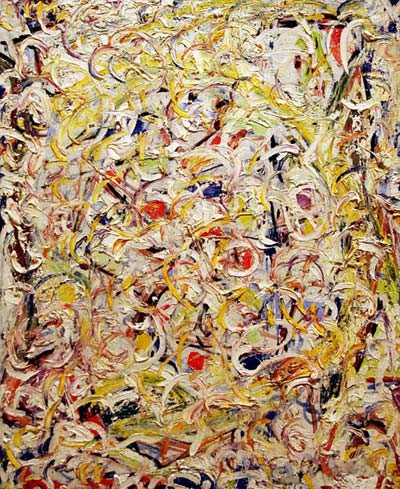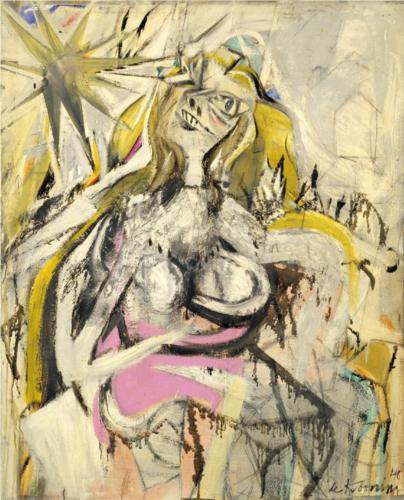PROJECT 3 : An exhibition of Abstract Expressionism
And here we go again, this time featuring art !
We're now profiling Abstract Expressionism, a pictural movement from the 20th century. The "Abstract Expressionism" term was initially used in 1946 for American art in order to qualify the works of Jackson Pollock and Willem de Kooning, two painters we are about to study here.
What is Abstract Expressionism ? This trend was characterized by the expression of various ideas including spirituality, the mind and the unconcious.The resulting paintings may not be so attractive from the first approach, but if you try to catch the in and the out, your spending time can easily become captivating. This is my aim for this exhibition.
What did Abstract Expressionism come from ? The roots of this trend are in European trends such as Futurism or Cubism and in German expressionism as well. What American painters made with that is mostly choosing a more open-minded route of painting. They chose to represent a larger view on the subject they're painting. Jay Meuser, who is one of the painters of our trend said : "It is far better to capture the glorious spirit of the sea than to paint all of its tiny ripples."
Now, on to the exhibition:
Just for
this exhibition to be structured properly and to keep sure everything is clear, let me give you a few explanations.
What you are about to see is abtract art, which means you might have troubles with understanding everything. This is why I will be separating the different explanations in two different parts. One being the overall description, and the other featuring the interpretations, and there we go now:
1 . Shimmering Substance by Jackson Pollock

Description:
Colors are everywhere. We have some white, some red, some blue, we have green yellow and brown as well as pink. It is still to point out that colours are not all playing the same role in this painting. So what are the different roles that colours are playing here ? White is the most present colour in this work. It fills the it giving it a background, while other colours like Red or Blue would be more of impactish touches. On another hand, yellow forms a circle around the center of the painting, something we will be explaining in the interpretations.
The overall shape of the piece isn't really clear. Some dark colours as deep green or deep blue may help the eye to imagine a frame around the painting, but all in all this is quite unestablished.
Interpretations:
"Colours" we said, and "Forms" we will tell. As interesting as it would be to go the "red is passion and white is purity" route, I feel like the most interesting and relevant way will be the one that includes forms and movements. It is to say that Jackson Pollock was famous in the artistic scene for his "dripping" technique. This way, he could represent music, dance, seasons and different other such themes through painting. Impressive isn't it ? And what if I told you this painting could be a storm ? What if I told you that I can see birds of every colour floating and dancing within a colourful feather whirlwind ? And how about fairies ? This is abstract art, this is Jackson Pollock, and I'm pretty sure that anybody could imagine their own very unique scenario to tell what's happening in the painting.
The easiest thing to figure out is -just as sold earlier- the stormish phenomenom occuring on the canvas. We can see some loads of different colours, of different thrown-on small unities moving everywhere. Pollock helped us by painting a sort of yellow circle in the middle of his work, suggesting a curved moving. We're talking about moves, how the hell did we not mention moves ? This painting is full of these, it is walking away as we're watching it, we need to catch it but we can't help. And what if this was the meaning of this storm ? Let's hold on to it, and take a look at this a bit closer.
We said it, Jackson Pollock was a master of translation. By just moving a brush, he would have been able to make us live in a parrallel world. The moves, it would all be in the moves. He used to suddently pick a brush and enter a sort of trance in which it wouldn't be his brain who would paint, but his heart. It was a matter of feelings, but what could his feelings be like while painting the shimmering substance ? The title sells it, he was thrilled. We can see it by the colours, which tend to represent joy. We can see it by the moves, which tend to represent passion. It is all curved, like no one knows where the line is going. It is all shining, like no one cares about knowing it. It's all damn shimmering and this is why we like it.
2. Untitled abstract female portrait by Willem de Kooning

Description:
This painting
by Willem de Kooning was never given a name, but I’m pretty sure we will find
enough elements to give it one.
We will consider the overall aspect of this painting first. As you can see it, the person who is represented here has not been the subject of a realistic representation. De Kooning was known for claiming he would not be apart of any trend. He did just paint, and wasn’t trying to make things look like anything else. One could also say his aim would be to paint like nobody else. The woman on the painting is what we call “ill-proportionned”. It means her body is out of proportions, as it follows no natural logic. We can still make out that she is blond-haired thanks to the yellow paint that was used for her hair. Colors are a bit various, as we can identify some black, some brown, some blue, some yellow, some pink and some white. Some lines are very thick, while some others are really thin. We can see a geometrical form on the right of the painting, which seems to be the beginning of an architectural plan. It doesn’t seem like the drawing was meticulously worked on, but still we are about to tell how genius De Kooning was for letting us with an apparently incomplete piece of art.
Interpretations:
We’re begginning with the incompleteness of this piece. This incompleteness as we’re mentionning it is obviously a lot more than a testimony of laziness from De Kooning. I’m not saying it is not of that nature, but I’m saying that if it is, it has to be considered seriously. Laziness, why not ? We said that De Kooning was an original. He loved painting things that he decided to paint, for his own and only profit. He was not into respecting a certain mode of creating , and if one day he would have felt like he couldn’t be bothered by working more on a painting, he would have decided to let it the way it was. And if he ever felt like painting again, he could totally begin something new for he wasn’t in the mood of working on the previous one. This is why the incomplete it looks, this painting is way far from lacking of anything. This little house on the right might be an interesting way to convey the following message: “I am a painter but I don’t care about seeming great, because fuck you that’s why.”
This was for the small housish form on the right of the painting. Now on to the person:
The woman who is decribed here might be a real person, but as this painting is nameless we cannot identify her, and we will probably never have the chance to do so. That seems interesting to me. Don’t you think this could be explored a little more ? let’s see. The woman on the painting is out of proportions as we said earlier, but she is also anonymous. Maybe she never existed, who knows ? What if she was De Kooning’s ideal woman ? “Ideal”, we catched it. This painting is a fair representation of the ideal. We were trying to imagine what the childish drawing on the right could be, and our dreams made us think of a house. We now try to figure out who this woman is, and what she would be like, and we realize she is perfection. She is perfection because she doesn’t follow anything, she is out of shape as we cannot guess who she is. She is out of space as we don’t know where she is and she is out of time as we don't know if she existed or not and when she would have existed. She is out of everything, and the human is a curious animal. We would like to catch her, and unmask her to finally know who she is. But we cannot do it, so we stay here, wondering what could his eyes be like. Haha, if we only knew, if we only knew that she is nothing but a shapeless mass of paint on a white canvas !
And I guess this will be all for our exhibition. I hope that you enjoyed it and found some interesting material in both analysis.
Aurélien
